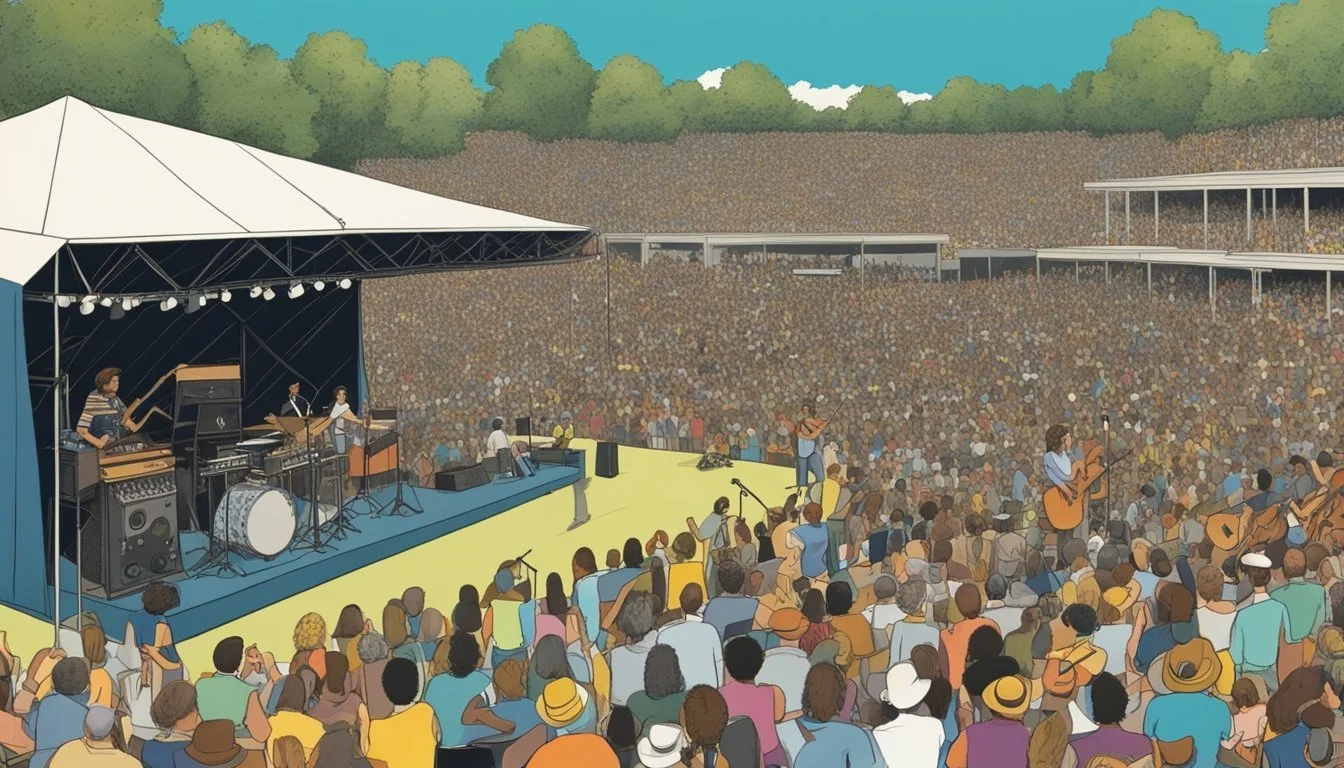Austin City Limits Willie Nelson 1974: The Legendary Performance That Changed TV!
On October 17, 1974, Willie Nelson stepped onto the stage to record the pilot episode of Austin City Limits. This groundbreaking performance marked the beginning of a legendary music series that would captivate audiences for decades to come.
The fledgling show, originating from Austin, Texas, showcased Nelson's unique blend of country, folk, and outlaw music. His set included classics like "Bloody Mary Morning," demonstrating the raw talent and charisma that would solidify his status as a country music icon.
Little did anyone know at the time that this pilot episode would be the catalyst for one of the longest-running music programs in television history. Willie Nelson's appearance set the tone for Austin City Limits, establishing it as a platform for authentic, high-quality musical performances that continue to inspire and entertain to this day.
The Genesis of Austin City Limits
Austin City Limits emerged in 1974 as a pioneering music television program. It captured the vibrant Austin music scene and brought it to a national audience, with Willie Nelson playing a pivotal role in its launch.
Conception and Origins
Austin City Limits was born from the creative minds of Bill Arhos, Paul Bosner, and Bruce Scafe. The trio envisioned a show that would showcase Austin's thriving music culture. Bosner, who commuted from Dallas, suggested the name after seeing the city limits sign regularly.
The creators aimed to bottle the electric atmosphere of Austin's music scene for viewers across the country. Their innovative concept filled a gap in television programming, offering authentic live music performances.
PBS embraced the idea, recognizing its potential to captivate audiences nationwide. The show's format was designed to highlight diverse musical talents, with a focus on the Texan capital's unique sound.
The Pilot Episode with Willie Nelson
On October 17, 1974, Willie Nelson and his Family band stepped into Studio 6A to record the Austin City Limits pilot. This pivotal moment set the stage for the show's future success.
Nelson's performance perfectly embodied the spirit of the program. His outlaw country style and magnetic stage presence captured the essence of Austin's musical identity.
The pilot aired in March 1975 as part of a national PBS pledge drive. It quickly became one of the network's top programs that year, securing Austin City Limits' future as a series.
Willie Nelson's involvement lent immediate credibility to the show. His participation helped attract other high-profile artists, establishing Austin City Limits as a respected platform for musicians.
Willie Nelson and Austin City Limits
Willie Nelson's performance on the Austin City Limits pilot episode in 1974 marked the beginning of a legendary partnership. His appearance set the tone for the show's future success and helped establish it as a premier showcase for live music.
Willie Nelson's Impact on the Show
Willie Nelson's involvement in the Austin City Limits pilot was crucial to the program's launch. On October 17, 1974, Nelson recorded the first episode, which became the foundation for 50 years of groundbreaking music television. His participation lent immediate credibility to the fledgling show.
Nelson's authentic country sound and outlaw image perfectly captured the spirit of Austin's music scene. This alignment helped Austin City Limits gain traction with viewers and attract other notable performers.
The success of the pilot led to Nelson becoming a frequent guest on the show over the decades. His ongoing relationship with Austin City Limits solidified its reputation as a platform for quality live music performances.
Setlist and Performance
Willie Nelson's setlist for the 1974 pilot showcased his signature sound and hit songs. While the exact details are not provided in the search results, it's likely that Nelson performed "Whiskey River" during this landmark show.
The performance captured the intimate atmosphere that would become a hallmark of Austin City Limits. Nelson's relaxed stage presence and expert musicianship set a high standard for future guests.
The pilot episode demonstrated the potential of the Austin City Limits format. It proved that capturing live performances in a studio setting could create compelling television for music fans across the country.
Legacy and Influence on Television History
Austin City Limits revolutionized music programming on television and set new standards for live performance broadcasts. The show's impact extended far beyond its local roots, shaping the landscape of music television for decades to come.
Ratings and Reception
Austin City Limits quickly gained a devoted following after its 1974 debut. Willie Nelson's pilot episode captivated audiences and set the tone for the show's authentic approach to showcasing live music. The program's popularity grew steadily, attracting viewers across the country. By featuring a diverse range of artists and genres, Austin City Limits appealed to music lovers of all backgrounds. Its success paved the way for other music-focused television programs and influenced the way networks approached live performance broadcasts.
Production Values and Historical Significance
The show's commitment to high-quality production values set it apart from other music programs of its time. Austin City Limits prioritized pristine audio and thoughtful camera work, ensuring that each performance was captured with clarity and intimacy. This dedication to quality helped establish the show as the longest-running music program in television history. In recognition of its cultural importance, Austin City Limits received the National Medal of Arts, becoming the only television program to earn this prestigious honor. The show's legacy includes launching and revitalizing careers, preserving musical performances, and documenting evolving trends in American music over five decades.
The Evolution of Austin City Limits
Austin City Limits transformed from a local Texas music showcase to a national institution celebrating diverse genres. The show's growth paralleled shifts in popular music while maintaining its core mission of showcasing authentic live performances.
Seasonal Developments
Season 1 of Austin City Limits aired in 1976, building on the success of Willie Nelson's 1974 pilot episode. Early seasons focused primarily on country, folk, and blues artists with Texas roots. As the show gained popularity, it began featuring a wider range of musical styles. Rock, jazz, and alternative acts joined the lineup in the 1980s and 1990s.
The program's visual style evolved as well. Early episodes had a simple, intimate feel with minimal staging. Later seasons incorporated more dynamic lighting and camera work while preserving the show's commitment to capturing genuine live music experiences.
From 1974 to Hall of Fame
Austin City Limits' influence grew steadily over the decades. The show earned a Peabody Award in 2011 for its contributions to American culture. In 2014, ACL launched the Austin City Limits Hall of Fame to honor legendary performers and key figures in the show's history. The inaugural Hall of Fame ceremony took place on April 26, 2014.
Willie Nelson, Stevie Ray Vaughan & Double Trouble, and show creator Bill Arhos were the first inductees. The Hall of Fame solidified ACL's status as a cornerstone of American music television, recognizing its role in showcasing and preserving exceptional live music performances for 50 years and counting.
Cultural Significance of Austin City Limits
Austin City Limits revolutionized music television and helped shape the landscape of American popular music. The show bridged genres and generations, becoming a cultural touchstone for both artists and audiences.
The Show's Role in Music and Country Genre
Austin City Limits played a pivotal role in expanding country music's reach and diversity. It provided a platform for both established and emerging artists, showcasing a blend of traditional country, outlaw country, and alternative country styles. The show's unique format allowed performers to present extended sets, giving viewers an intimate concert experience.
Willie Nelson's 1974 pilot episode set the tone for the program's authentic approach. This authenticity resonated with audiences and artists alike, establishing Austin City Limits as a respected venue for musical expression. The show's influence extended beyond country, featuring rock, blues, and folk performers, contributing to genre-blending and cross-pollination of musical styles.
Influence on Austin and the Music Industry
Austin City Limits significantly impacted Austin's music scene and economy. The show put Austin on the map as a live music destination, attracting musicians and music lovers to the city. This influx contributed to Austin's growth as a cultural hub and helped coin its nickname, "The Live Music Capital of the World."
The program's success led to its induction into the Rock and Roll Hall of Fame, the only television show to receive this honor. Austin City Limits influenced the music industry by providing a model for other live music shows and festivals. Its emphasis on quality performances and diverse lineups inspired similar events across the country.
The show's legacy continues through its annual music festival and its impact on music discovery, helping launch careers and introduce new artists to national audiences.





